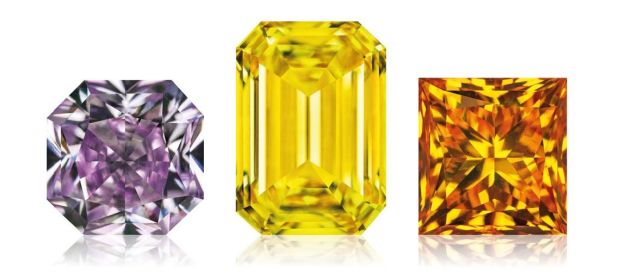| The Big Fancy ABCs & Fancy Colour Meets Fancy Shape |
 |
| In this Edition: |
 |
|
|
|
Dear Customers and Friends of Coloured Diamonds:
We hope that you have all come through this rather calm time well and healthy! We were very happy to receive your many encouraging good wishes, greetings, and thanks!
Unfortunately, we were not able to welcome you to Inhorgenta this past February as we have done for the last 20 years. We did, however, put our time to good use by rummaging through our collection where we came across some very interesting cuts. As the title of this edition of our newsletter, "Fancy Colour Meets Fancy Shape", suggests, you should find both inspiration and new ideas.
Our Big Fancy ABCs continues, and we are back in this edition with the letters G to J.
An enriching addition to our company is our new light box, the GemLightBox Macro - You will be carried away by the beautiful shots of the stones. |
 |
In the future, we will be able to delight you with great shots and videos of our merchandise – but be patient, as we are just getting started!
We have also been using our time to catch up on our reading! Be sure to take a look at our recommended reading.
So, let’s get going! Spring is here and we are ready for new projects and look forward to seeing you soon!
Your teams from Kulsen & Hennig GbR Berlin and Dominik Kulsen AG from Winterthur
Juliane Hennig
|
|
When their colours are pure, both green and gray diamonds possess a cool, classic beauty. When their colours are mixed with the common secondary colours of yellow and brown, however, the diamond’s overall appearance becomes much warmer. And, of course, when green and gray come together in Fancy Greenish Gray and Fancy Grayish Green diamonds, the result is especially lovely.
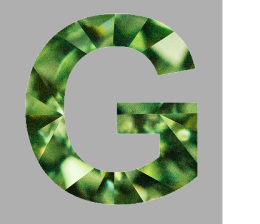 |
Natural radiation causes the colour green in diamonds. It occurs in nature when rough diamonds come in close contact with uranium or thorium during formation.
These radioactive elements emit particles with high energy and cause defects in the crystal lattice of the diamond. If the irradiation does not penetrate deeply enough into the diamond, the rough diamond is only coloured green superficially and the green colour is then lost during the cutting process.
|
Only diamonds with a continuous green body colour, where the irradiation has penetrated the entire stone, still show a green colour after cutting.
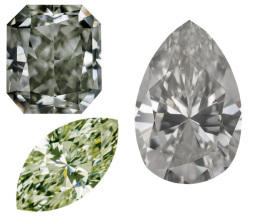 |
Regarding gray diamonds, one cause of colour can be deposits of boron or hydrogen atoms in the crystal lattice. These deposits cause certain wavelengths of white light to be absorbed.
Another cause can be tiny dark inclusions in the transparent diamond, like for example minute graphite concentrations of carbon. |
The so-called “Silver” diamonds, also known as “Salt & Pepper” diamonds, are an affordable alternative to gray diamonds. These are colourless diamonds that appear gray due to visible inclusions.
|
|
The name "diamond" comes from the Greek word "adamas" and means "invincible" or "indestructible." As in Greek, particularly hard materials were also referred to as adamas in classical Latin.
 |
It is reported that the first diamonds were found in India in the 4th century BC. However, it is believed that the first diamond discoveries actually took place in India as early as the 18th century BC. Even then, diamonds were said to have magical effects, which is why they were also used as talismans.
Although it is impossible to determine exactly when the diamonds found in India began to spread in the West, it was not until the 13th century that it was discovered that diamonds could be fashioned. |
The valuable stones were initially transported via the Silk Road and then, starting in the 15th century, via the Cape of Good Hope. Lisbon, Bruges, and Venice were the most important trading centres at the time.
In the 16th century, Antwerp developed into the main trading centre. About half of the world's trade took place there. Up until the 18th century, India was the only place where diamonds were found. During the 18th century, however, the Indian and Indonesian mines gradually became exhausted.
When a Portuguese miner was searching for gold in Brazil, he discovered the first diamond outside Asia. This discovery caused a "diamond rush".
The first diamond from a kimberlite host rock was found in 1869 in Kimberley, South Africa. One year later, South Africa took over the role of main supplier, as finds in Brazil also became rarer.
Since then, the majority of diamonds come from Africa. The four main producers are currently Russia, Botswana, the Congo, and Canada.
At the beginning of the 20th century (around 1910), the brilliant cut we know today, characterized by a particularly high brilliance, was developed.
In 1955, the first artificial diamond was produced.
To this day, the diamond has not lost any of its radiance and attraction and is still the most sought-after gemstone in the world.
|
|
 |
India is located in South Asia and is the seventh largest country in the world. The Federal Republic of India is formed by 28 states and comprises 8 union territories. The proper name of the country is the Republic of India or the Bharat Ganarajya (Hindi) in the two official languages valid throughout the country. The country’s natural border in the north and northeast is formed by the Himalayas, the highest mountain range in the world. These mountains are also the source of India's longest and most important river, the Ganges (also called the Ganga). |
India has always been the traditional land of gemstones. To date, the country has had and still has many of its own deposits, including agate, alexandrite, amazonite, aventurine, chalcedony, garnet, jasper, labradorite, ruby, sapphire, and of course ... diamonds! This fascinating world of gemstones permeates all spheres of Indian society, whether in religious, cultural, or social interaction. All gemstones, but especially diamonds, are considered a gift from the gods.
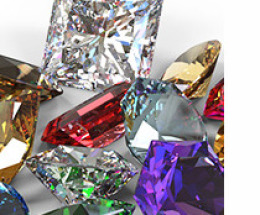 |
Nowhere else in the world is the passion for gemstones and the expectation of their auspicious properties so pronounced. Both men and women have a long tradition of wearing and showing precious stones. As a matter of fact, jewellery forms can even be seen on the wall paintings in the ancient caves of Ajanta and Ellora which date back to between the 2nd century BC and the 6th century AD. |
Over 90 percent of the diamonds sold worldwide today are cut in India, mostly in the city of Surat. Mumbai and Surat have overtaken the traditional diamond centres of Antwerp and Tel Aviv, and the economic importance of Indian diamond traders has grown enormously. According to unofficial figures, about 80 percent of the diamond trade is now firmly in Indian hands. Freddy Hanard, director of the Antwerp World Diamond Center, estimates India’s market share at somewhere between 60 and 70 percent.
At Kulsen & Hennig, we also travel to India regularly, bringing back many colourful treasures for you from there. We feel strongly about giving something back to this wonderful country and actively support an organisation in South India which is particularly close to our hearts:
The Regenboog India Foundation:
The development projects implemented and supervised locally by the Regenboog India Foundation are supported by donations from the Arunachala Rising Sun (ARS) association. With love, commitment, and devotion, the team members show tireless dedication and accompany young people out of poverty into a future worth living. |
 |
|
|
J - Jean Baptiste Tavernier
Jean Baptiste Tavernier (* 1605 in Paris; † 1689 in Moscow) was a French merchant traveller.
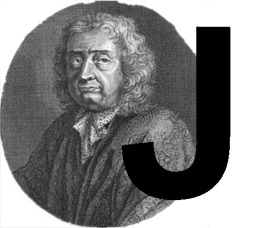 |
Between 1628 and 1668, Jean Baptiste Tavernier undertook major journeys to the Orient, Turkey, Persia, and India. He made six journeys by land and one by ship.
He became famous for his diaries, in which he documented his journeys in great detail. His most famous work, which is still published today, is Travels to the Riches of India/Adventurous Years with the Great Mogul 1641 - 1667. |
Tavernier brought a large quantity of diamonds back to Europe from his travels, including twenty stones between 30 and 50 carats.
Some of the diamonds he brought back from India were later to become famous, such as the Blue Hope diamond, which according to legend he stole from a statue of the Hindu god Vishnu.
In 1668, Tavernier sold the Hope diamond to King Louis XIV of France. He rose in rank to become the most respected diamond expert and dealer of his time in the royal courts of Europe. At that time, there were no great diamonds that he had not brought back from India or at least appraised and measured for the princes.
Read more about Jean Baptiste Tavernier from one of our previous newsletters:
|
|
Fancy Colour Meets Fancy Shape
The term "Fancy" in English means, of course, fancy, but also unusual, original, or even chic. Only diamonds with a clearly recognisable colour that produces a certain effect when viewed from a distance deserve the prefix "Fancy". The term "Fancy Colour" is derived from "Fancy Shape".
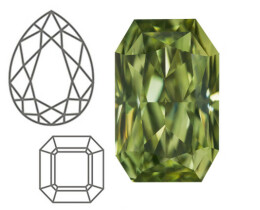 |
“Fancy Shape" refers to all diamond cuts that deviate from the most classic cut of all, the brilliant cut.
While colourless diamonds are often cut in the brilliant cut, coloured diamonds (Fancy Colour Diamonds) are often cut in fancy cuts (Fancy Shape Diamonds), as these cuts can intensify the colour of the diamonds. |
Accordingly, "Fancy Colours" are all possible colours in which diamonds can occur. Diamond colours can occur with only one colour (pure coloured diamonds) or combined as main and secondary colours (mixed coloured diamonds). Since the diamond is the gemstone with the widest colour spectrum, there are hardly any two stones that are exactly alike.
|
|
Heart / 0.34 ct / Fancy Deep Brownish Yellowish Orange / SI /
5.30 x 4.60 x 2.25 mm / GIA
Pentagon (Step Cut) / 0.36 ct / Fancy Deep Brown Orange / I /
6.14 x 4.69 x 2.10 mm / GIA
Oval / 0.41 ct / Fancy Intense Green Yellow / VS2 / 6.28 x 3.57 x 2.17 mm / GIA
Octagon (Brilliant) / 0.43 ct / Fancy Yellow / SI1 / 4.19 x 4.16 x 3.19 mm / GIA
Bead (Pair), Drilled / total: 1.36 ct / Black (Heated) /
4.37 x 4.62 x 3.56 mm / 4.45 x 4.68 x 3.70 mm
Mixed Shape / 1.11 ct / C4 / VS / 5.40 x 4.92 x 5.78 mm
Mixed Shape / 0.11 - 0.29 ct / Fancy Mixed Orange / SI - VVS
Square (Step Cut/ Cut Corner) / 1.02 ct / C2 / SI / 5.37 x 5.32 x 4.01 mm
Radiant / 0.47 ct / Fancy Vivid Orangy Yellow / SI1 / 4.63 x 3.83 x 3.21 mm / GIA
Trilliant / 0.49 ct / Fancy Deep Orange Brown / VS / 5.30 x 5.27 x 2.95 mm
Kite (Step cut) / 0.62 ct / Fancy Deep Brown Orange / SI /
6.53 x 5.10 x 4.14 mm / GIA
Firerose (Octagonal) / 0.65 ct / C7 / I / 5.45 x 5.24 x 3.11 mm
Rose Cut (Full Dutch) / 1.32 ct / C7 / SI / 6.96 x 7.03 x 3.15 mm
Briolette, Drilled / 1.63 ct / C7 / I / 4.85 x 5.60 x 7.00 mm
Baguette / 0.52 ct / Fancy Deep Orange Yellow / I / 5.48 x 3.84 x 2.59 mm / GIA
Emerald Cut / 0.87 ct / C7 / SI / 6.37 x 4.91 x 3.12 mm
Rose Cut (Irregular) / total: 8.62 ct / Dark Gray / I3 /
19.82 x 13.94 x 2.29 mm / 19.99 x 14.20 x 2.67 mm
Calf's Head (Step Cut) / total: 3.74 ct / Black (Heated) /
7.90 x 7.73 x 3.20 mm / 8.01 x 7.85 x 3.50 mm
Rose Cut (Irregular) / total: 3.14 ct / Black (Heated) /
7.85 x 7.85 x 3.07 mm / 7.86 x 7.54 x 3.21 mm
Rose Cut (Oval) / total: 1.28 ct / Yellow / I3 /
5.83 x 5.51 x 1.91 mm / 5.83 x 5.50 x 2.12 mm
|
|
Recommended Reading – A Diamond in the Dust
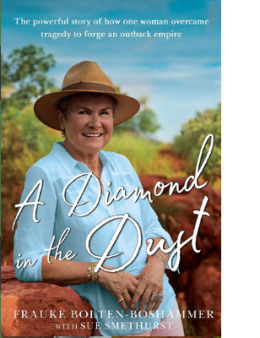 |
Frauke Bolten-Boshammer
A Diamond in the Dust - The story of a strong woman who builds a diamond empire in the Australian outback.
"Germany will always be my homeland, but now Australia is my home."
|
In her book A Diamond in the Dust, Frauke Bolten-Boshammer tells her very personal life story and how she became one of Australia's most successful diamond traders in one of the most unforgiving regions on earth.
When she was 17, Frauke met and fell in love with her future husband, Friedrich Bolten. They married and had three children together. After a ten-month stay on a farm in Africa, the two decided to emigrate and begin a new chapter in their lives in Kununurra, Australia. Tragedy struck a few years later, however, when her husband committed suicide and Frauke was left in Australia trying to keep the family afloat as best she could.
Eventually, she used part of her late husband's life insurance to buy shares in the successful jewellery company Brinkhaus Jewellers, the best jewellery shop in Perth. This was the start of her stellar career as a successful jeweller, and she eventually succeeded in building a new life for herself and her family in Australia.
Today, Frauke Bolten-Boshammer says of her new home: "The outback can be a terribly lonely place, but it's also a place where you can find love when you least expect it."
Click here to read the book!
Note: After 40 successful years, Australia's Argyle mine is now exhausted and has finally been closed after much advance notice. The area is now to be rehabilitated and renaturalised. The Argyle mine was famous for its particularly beautiful pink and champagne diamonds and supplied about 90 % of the pink diamonds in the world.
At Kulsen & Hennig, our stock also includes champagne-coloured diamonds with a certificate of origin from the Argyle mine. If you are interested, please contact us.
|
|
How about Some Refreshment?
Find of the Week: Drinking Pleasure with Style!
Diamond-shaped ice cubes - a must-have for every gemstone fan! |
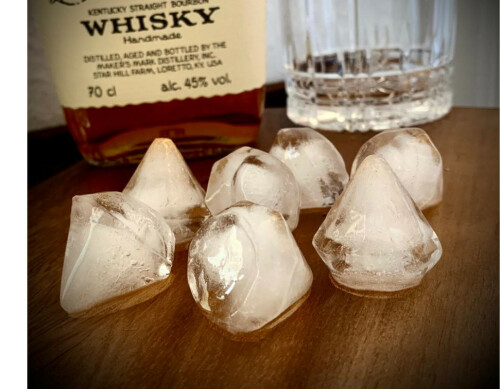 |
|
|
|
